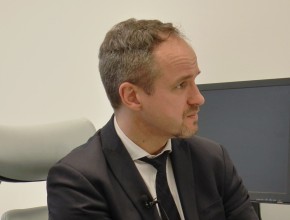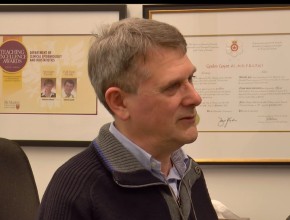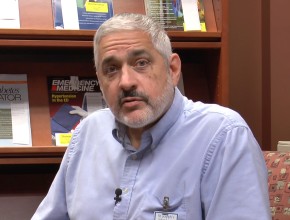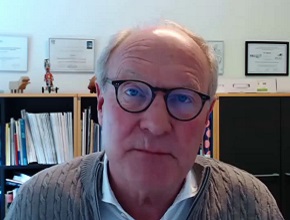References
Busse JW, Craigie S, Juurlink DN, et al. Guideline for opioid therapy and chronic noncancer pain. CMAJ. 2017 May 8;189(18):E659-E666. doi: 10.1503/cmaj.170363. PubMed PMID: 28483845; PubMed Central PMCID: PMC5422149.Renthal W. Seeking Balance Between Pain Relief and Safety: CDC Issues New Opioid-Prescribing Guidelines. JAMA Neurol. 2016 May 1;73(5):513-4. doi: 10.1001/jamaneurol.2016.0535. PubMed PMID: 26978030.
Roman Jaeschke: Good afternoon. Welcome to another edition of McMaster Perspective and another presence of Professor Gordon Guyatt with us. Gordon, you were recently participating in practice guidelines on opioid use. I think the guidelines are not yet finished. [The guidelines were published after this interview was recorded.] What can you tell us at this stage? What led to it? How does it position your guidelines among other guidelines available?
Gordon Guyatt: The last decade has seen a very marked increase in the use of opioids as treatment for chronic noncancer pain. There was a Canadian guideline published in 2010, which was basically a guideline on how to use opioids. That was reflected by half of a community that is out there. [One part of] the community is clinicians who believe that opioids are an important benefit, that they really reduce pain in an important way, and their risks are very limited in patients with chronic noncancer pain. There is another community of a very aggressive set of folks who say, “This is terrible, there is an epidemic of opioid prescribing, it is doing awful things to people, it is making them addicted, you have overdoses, you have deaths, and we should really stop using these opioids.” So you have these polarized communities out there.
The folks who are shouting “too much opioids” have recently gained a lot of traction, and they have gained a lot of traction because they have started to appear in the public press and governments have decided that they need to do something about this. In the Canadian governments, there is a big concern about the very much increased opioid use. So Jason Busse, one of colleagues here, put together a guideline panel and got an appreciable amount of money from the Canadian government to do a good job of coming up with opioid guidelines.
The way we did the guidelines [when] you have these 2 polarized communities of experts, we decided to have a panel of nonexpert clinician methodologists who in their clinical practice see individuals with pain and have used opioids. The panel met with these 2 constituencies for 2 full one-day meetings, where the panel listened to the experts, we got their input, and the nonexpert panel made its recommendations.
Meanwhile, the Centers for Disease Control and Prevention (CDC) put out their guidelines, which got a lot of press and a lot of uptake, including by Canadian governments, who took the opioid guidelines from the CDC, which said, for example, that you probably should not give more than 50 morphine-equivalent dose, and certainly less than 90 – which is much less than many, many, many people are getting in Canada at this point. CDC guidelines were, we believe, limited. They did not do a great job at looking at the evidence, they made rules about the evidence that seemed inappropriate to us, they did not apply the rules of going from evidence to recommendations as well as they should. And in particular, they did not address what we think is a major problem which surfaces when you talk to patients – and we did talk to patients, the individuals, the tens of thousands, maybe hundreds of thousands of Canadians who are way over this dose – what is going to happen to them, how should we manage such patients, how could we help such patients. So those were major limitations of the CDC guidelines, which our guideline will address.
Roman Jaeschke: Thank you for this. You mentioned randomized trials. Were they against placebo or...?
Gordon Guyatt: Yes, these were against placebo. These are people who hopefully – although many of the trials are unclear – who hopefully have been optimized on nonopioid drugs and the question is...
Roman Jaeschke: So this would be in addition to nonopioid treatment. There was a moderate amount of benefit...
Gordon Guyatt: I would not even say moderate, I would say modest. So, to put it this way – you are measuring pain. You measure it typically on a visual analog scale from 0 to 10. What is the mean effect? Turns out that the mean effect on 0 to 10 scale is about...
Roman Jaeschke: I would expect 3 or 4.
Gordon Guyatt: Yeah, it is about 0.8.
Roman Jaeschke: Really?
Gordon Guyatt: Yeah! When I say modest effect, I mean a modest effect.
Roman Jaeschke: Could we compare it to effects of other analgesics?
Gordon Guyatt: Yeah, it is similar. And we really have to distinguish people who would say “anybody who has had surgery and knows what happens immediately after surgery would find this quite astounding.” But it is clearly a different story when you are giving chronic opioids over days, weeks, months, or years than in an acute pain situation. Very different. And the situation is, when you are giving it chronically, on a 10 cm scale, it is less than one unit, so the average is 0.8. So it is very modest.
Roman Jaeschke: What could you tell us about the actual recommendations?
Gordon Guyatt: I could tell you that you have to hold your breath and wait to see exactly what we are going to recommend, because – you can look on the websites and so on – we are going to have a period of public consultations for a month. It would be inappropriate to say “these are our recommendations” until we get the feedback and have a chance to consider the feedback. Maybe things will change, maybe we will hear things that will change our recommendations in an important way...
Roman Jaeschke: So I guess we will have part 2?
Gordon Guyatt: You will have part 2 and then you will hear the lowdown.
Roman Jaeschke: But the important message for me is the surprisingly modest effect of opioids.
Gordon Guyatt: I would say surprisingly modest effect of opioids and – relative to public hysteria – the modest increased risk of bad things happening.
Roman Jaeschke: To non-street drug use, which may be a different story with the epidemics of fentanyl...
Gordon Guyatt: I think people are getting the things confused. That is absolutely right. The street drug use is a huge problem with really important numbers of deaths. With the appropriate use in chronic noncancer pain, there are risks, but they are very small.
Roman Jaeschke: Thank you.
 English
English
 Español
Español
 українська
українська











